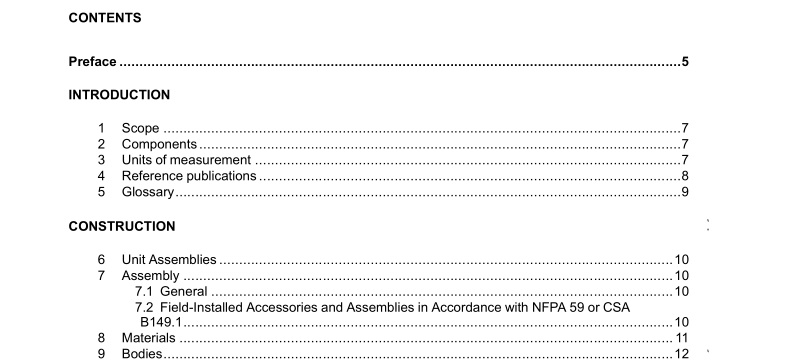UL 109-2020 pdf download.Tube Fittings for Flammable and Combustible Fluids, Refrigeration Service, and Marine Use.
2.1.3 A component shall be used in accordance with its rating established for the intended conditions of use. 2.1.4 Specific components are incomplete in construction features or restricted in performance capabilities. Such components are intended for use only under limited conditions, such as certain temperatures not exceeding specified limits, and shall be used only under those specific conditions. 2.2 Units of measurement 2.2.1 Values stated without parentheses are the requirement. Values in parentheses are explanatory or approximate information. 3 Instructions 3.1 The manufacturer shall provide a copy of the instructions or equivalent information intended to accompany Marine-Use fittings, which cover the proper method of preparing the tubing, assembling and making up the fitting, as well as specifications as required concerning the proper tools to be used. These instructions are to be used in the examination and test of the fittings and, for this purpose, are not required to be in final printed form. DESIGN AND CONSTRUCTION 4 General 4.1 Tube fittings shall be of the flare, inverted flare, threaded-and-ball-sleeve compression, and other types for use with copper, brass, aluminum, and steel tubing. 4.2 Tube fittings shall be designed and constructed to be equivalent in mechanical strength, provisions for assembly and disassembly, and resistance to corrosion to tube fittings conforming to the Standard for Automotive Tube Fittings, SAE J512; Cast Copper Alloy Fittings for Flared Copper Tubes, ANSI/ASME B16.26; or the Standard for Refrigeration Tube Fittings – General Specifications, SAE J513. 4.3 The design of the fitting shall be such as to minimize the risk of incorrect assembly, such as reversal of components.
5.2 A Marine-Use fitting and component part shall have less than 38 percent zinc content or include inhibitors to attain equivalent resistance to dezincification. Metals shall be machined, forged, or extruded and shall be designed for use in salt atmosphere and shall not be affected significantly by submersion in salt bilge water. 5.3 Fittings for gas and refrigeration service shall be machined, forged, or extruded. 5.4 With reference to 5.2 and 5.3, the fitting shall be capable of withstanding, without cracking, the i Moist Ammonia Air Stress Cracking Test, Section 11, for copper and copper alloys. 5.5 Carbon steel shall have a protective coating equivalent to that afforded by a cadmium or zinc plating 0.0002 inch (0.005 mm) in thickness plus a chromate treatment or phosphate coating. 5.6 Carbon steel and stainless steel Marine-Use fittings for use with seamless steel tubing in diesel engine fuel systems shall be resistant to corrosion in salt atmosphere. Stainless steel fittings shall have corrosion resistance equivalent to that of stainless steel No. 304. 5.7 The composition of metal alloys used for the fabrication of Marine-Use fittings shall be of known characteristics for normal corrosion resistance, dezincification resistance, and galvanic compatibility with other parts of the fuel system. The material shall be tested, when required, by a salt water atmosphere exposure test. The test is to be conducted for 500 hours. 5.8 Fittings shall be fabricated of a material having a melting point (solidus temperature) not less than 950°F (510°C). 5.9 Brazing material if used, shall have a melting point (solidus temperature) in excess of 1000° F (537°C). 8.2 Two samples of each size fitting are to be used for this test. 8.3 For these tests, amplitude is the maximum displacement of sinusoidal motion from position of rest or one-half of the total displacement of the fitting. 8.4 Each end of a length of annealed copper tubing is to be connected, in accordance with the manufacturer’s instructions, to one of the two fittings to be tested. The tubing is to have the wall thickness for the size as indicated in Table 8.1. 8.5 The length of tubing for the test is to be that required to conform to the arrangement for each size as illustrated in Figure 8.1 or Figure 8.2. 8.6 The pipe-threaded ends are to be snugly fitted into metal blocks as shown in Figure 8.1 and Figure 8.2. One block is to be securely attached to the vibrating table and the other to a stationary structure. The arrangement is to be such that the fittings and tubing are maintained under air pressure of 50 pounds per square inch (psi) (345 kPa) throughout the test.UL 109-2020 pdf download.
UL 109-2020 pdf download
